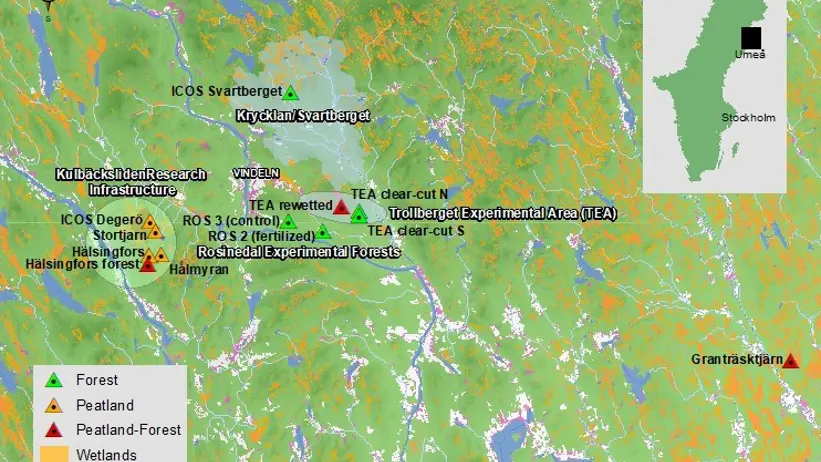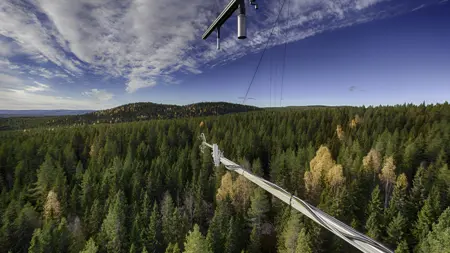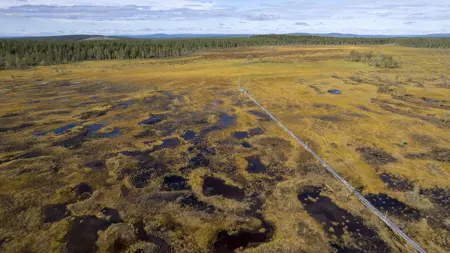Projects in the Boreal biosphere-climate interactions group
Ongoing projects
The projects in the Boreal biosphere-climate interaction group span five areas (The Krycklan catchment study, Trollberget, Kulbäckliden, Rosinedal, and Bullmark) located in Northern Sweden. Within these locations there are a number of monitoring sites where measurements for various environmental variables are conducted.

This page lists ongoing forest research projects within the boreal biosphere-climate interactions research group.
Does sustained yield of forest biomass result in a carbon sink at the forest landscape scale?
The project goal is to estimate the full carbon balance of a managed boreal forest landscape (i.e. the Krycklan catchment) using tall tower eddy covariance measurements and bottom-up scaling based on detailed plot-level measurements of terrestrial and aquatic carbon fluxes combined with high-resolution Lidar data.
Project period: 2016-2018
Funded by Formas
Ecosystem carbon and water fluxes in boreal forests
This project explores the ecosystem carbon and water fluxes at the Rosinedal and Svartberget forests using the eddy covariance technique. At Rosinedal, we also investigate the effect of ecosystem-scale N addition on these fluxes.
The project is part of the Wallenberg project: Branchpoints.
Funded by the Wallenberg Foundation
Exploring the Greenhouse Gas Balance of a Boreal Forest Landscape using Tall Tower Eddy Covariance Measurements
With the tall tower eddy covariance measurements of CO2, CH4, and H2O fluxes (Svartberget), the GHG budgets can be derived directly for the Krycklan catchment on the landscape-scale. In addition, local source and sink contributions to this direct landscape-scale estimate will be investigated via advanced footprint modelling.
Funded by the Kempe Foundation
How does rewetting affect the greenhouse gas balance of drained peatland forests in boreal Sweden?
The overall aim of this project is to investigate how rewetting affects the GHG balance of drained peatland forests in boreal Sweden. This will be achieved by eddy covariance measurements of the ecosystem-scale CO2 and CH4 exchanges in work package 1 (WP1), combined with estimates of spatial variability from plot-scale GHG flux measurements across replicated sites in WP2. In WP3, the separate responses of the individual net CO2 exchange component fluxes will be determined.
Funded by Formas
Towards climate-responsible forestry: Assessing the greenhouse gas balances of drained and restored peatland forests in boreal Sweden
The main goal of this project is to estimate and compare the GHG balances (including CO2 and CH4 exchanges) of drained and restored peatland forests in boreal Sweden. The specific project objectives are to:
(1) obtain direct measurements of the full annual ecosystem-scale GHG balance of a drained nutrient-poor peatland forest,
(2) determine the impact of restoration activities (i.e. rewetting) on the GHG balance of drained peatland forests,
(3) identify the factors that govern the spatio-temporal dynamics of CO2 and CH4 exchanges in drained and restored peatland forests.
Funded by Skogssällskapet
Understory carbon and water budgets in boreal forests measured from the below-canopy eddy covariance towers.
Boreal forest floor plays a significant role in the ecosystem-scale carbon and water dynamics in boreal forests. However, accurate quantification of understory's contribution is quite challenging due to e.g. non-ideal conditions for the below-canopy eddy covariance measurements. In my project, I will use the direct below-canopy eddy covariance towers as well as manual chamber measurements to assess the carbon and water budgets of forest floors in two contrasting boreal forests, Svartberget and Rosinedal, respectively, to provide a better understanding of the mechanisms in carbon and water cycles in boreal forest ecosystems.
Funded by the Kempe Foundation

This page lists ongoing peatland research projects within the boreal biosphere-climate interactions research group
Advancing the modelling of the peatland carbon balance through assimilation of high-resolution component flux and phenology data
Our project aim is to advance a well-established peatland C cycle model by incorporating high-temporal resolution observations of
i) individual net carbon dioxide (CO2) exchange component fluxes and
ii) vegetation phenology.
The specific objectives are:
1) To obtain novel empirical data on the individual peatland production and respiration component fluxes at high temporal resolution
2) To improve model algorithms for estimating autotrophic and heterotrophic respiration fluxes in boreal peatlands
3) To develop a dynamic vegetation model for improving simulations of peatland gross primary production and allocation to above- and belowground net primary production
Funded by the Swedish Research Council
Bridging scales: Carbon and greenhouse gas budgets from the plot to regional level in boreal Sweden
The project goal is to assess and cross-validate carbon and GHG budgets from plot to regional scales in boreal Sweden using chamber measurements, eddy covariance and atmospheric transport modelling.
Project period: 2019-2021
Funded by the Kempe Foundation
How does drainage and ditch maintenance affect the greenhouse gas balance of forested peatlands in the Swedish boreal landscape?
The project goal is to estimate the effects of drainage and ditch maintenance on the greenhouse gas balance of drained peatland forests in the Swedish boreal landscape using eddy covariance and chamber measurements.
Project period: 2017-2019
Funded by Formas
How does rewetting affect the greenhouse gas balance of drained peatland forests in boreal Sweden?
The overall aim of this project is to investigate how rewetting affects the GHG balance of drained peatland forests in boreal Sweden. This will be achieved by eddy covariance measurements of the ecosystem-scale CO2 and CH4 exchanges in work package 1 (WP1), combined with estimates of spatial variability from plot-scale GHG flux measurements across replicated sites in WP2. In WP3, the separate responses of the individual net CO2 exchange component fluxes will be determined.
Funded by Formas
Studying the impact of N fertilization on the CO2 and CH4 exchanges of a boreal nutrient-poor mire
The overarching goal of the project is to obtain an in-depth understanding of the peatland C cycle response to increased N input using an automated chamber system established on natural, moss and bare peat plots. More specifically, this set up will enable to study the effects of N fertilization on the individual carbon dioxide (CO2) and methane (CH4) exchanges and their various underlying component fluxes.
Funded from the Kempe Foundation
For more information on Current Projects; see the research catelogue here